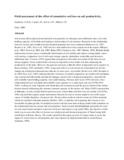| dc.description.abstract | Soil erosion affects physical and chemical soil
properties by reducing water infiltration rates,
soil water holding capacity, soil fertility and
leading to deterioration of soil structure.
Research on the relationship between erosion and
soil physical and chemical properties has been
conducted (Battison et al., 1987; Becher et al.,
1985 ; Frye et al., 1982) but few such studies have
been carried out in the tropics (Mbagwt et al.,
1984; Yost et al., t985; Lal, 1985; Belay,1992;
Casanova et al., 1987; Merete, 1992). Results
mostly indicate that erosion causes considerable
deterioration of soil fertility and reduces rooting
depth, causes soil crusting, compaction, loss of
soil water storage capacity, diminishes
workability and decreases infiltration rates.
Crosson, (1935) argued that consequences of
eroded soil carried off the farm are not always
negative. Some eroded fertile soil may be
deposited on less fertile soil, thus enhancing the
productivity of the latter. However, the general
consensus is that the effect of deposited soil is
negative in Kenya (Otieno, 1993; Schneider,
1993).
Long-term effects of soil erosion on soil
productivity involve changes in soil physical
characteristics that are, in most cases, irreversible
(Foster et aI.,1985; Bramble et al.,1985).Frye et
al. (1982) indicated that the A-horizon of eroded
compared to un-eroded soils had higher clay
content and bulk density and that the damage
caused to the soil physical properties,
especially the soil available water holding
capacity, were yield-limiting. Thomas and Cassel
(1979) showed a close relationship between soil
depth and available water capacity on a sandy
loam soil. Lal (1976b,1981, 1985), working on
some Nigerian soils found that soil erosion
increased the gravel content of the surface
horizon thereby influencing the moisture
retention capacity of the surface soil. Belay
(L992) reported that in Ethiopia, severely eroded
Nitisols had lower pore volume than soils that
were not eroded. Lal (1976a, 1985) reported that
organic matter and nutrient element loss due to
erosion might be one of the major causes of
fertility depletion of tropical soils. Erosion often
results in selective removal of fine materials
which are enriched with plant nutrients (Kefeni,
1992), so that the soil remaining after erosion is
less favourable for plant growth.
No detailed research work has been done in
Kenya under field conditions on the relationship
between erosion and soil properties. Such
research should highlight and justify the need for
soil conservation measureb to prevent soil losses
and improve crop yields.'Thus, the objective of
this study was to assess the effect of erosion on
soil physical and chemical properties of Nitisol
using field runoff plots at Kabete, Kenya. The
results reported in this paper are part of a larger
study to assess the impact of soil erosion on soil
properties and crop response on high potential
land in central Kenya (Gachene, 1995). | en |

